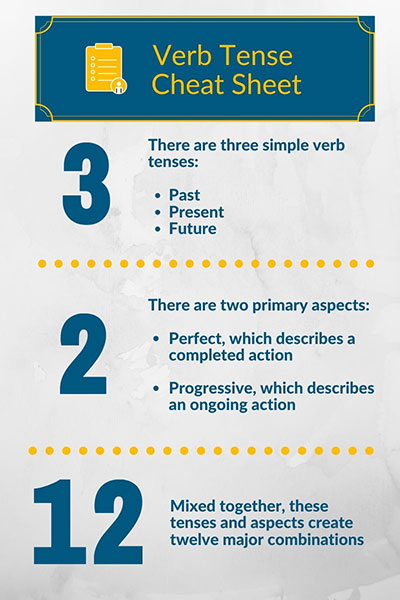Written by Scribendi
When studying a foreign language, one of the biggest challenges learners face is verb conjugation. Some languages are plagued with irregular verbs. Others, like German, move the position of the root verb to indicate the past tense. So many rules to follow! So many endings to memorize!
It will probably come as no surprise to hear that learning verb tenses in English is no walk in the park, either. As a language that haunts ESL learners with its spelling irregularities and seemingly random article usage, English can also be kind of confusing when it comes to verb tenses.
But never fear, this comprehensive guide to English verb tenses is just the crash course you need to get your perfects and progressives straight. You might even learn some things you didn't know about the history of the English language, too.
The English Language: A Historical Overview
English is a fairly unique language that developed out of England's long early history of occupation. Unlike other European languages, it doesn't stem from a single language family. Its linguistic roots are Germanic, Scandinavian, French, and Latin.
Here's how it happened.
Shortly after the Celts—the ancestors of today's Welsh and Irish—repelled the Romans, the Anglo-Saxons invaded what is now known as England. Although there weren't many of them, they changed the Celtic languages in some key ways, such as adding the interrogative.
The Vikings were the next wave of Germanic invaders to settle down in England. They assimilated into the native population, and Old Norse words and language patterns gradually became interwoven with Old English. The Normans—Vikings who had first settled in northern France—came a few centuries later, adding 10,000 French words to the English language.
As these waves of war and invasion came and went, England began to consolidate its power within a few different kingdoms, which were unified by the end of the fifteenth century. England's rise to a global power, the invention of the printing press, and the Reformation added some final touches to the evolving English language. Scholars began to take an interest in this language of the common people; however, they wanted it to appear more erudite. Consequently, a number of Latin words were added into the mix.

The Controversy over Verb Tense
According to some modern linguists, the English language has only two tenses: the past and the present. That's because all of the other tenses are formed by adding auxiliary verbs, such as "be," "do," and "have." In those tenses, the root verb doesn't change; they are not morphological. In other words, because only the past and present tense are, in fact, morphological—"I saw the bear; now, it sees me"—they are the only tenses that count.
Others linguists argue that morphology doesn’t matter. Rather, they stress that the "will" or "shall" one adds to make the future tense—"I will get up in a minute"—has undergone a grammatical shift, rendering it unimportant as a word in its own right when it is used for the purpose of changing tense. In other words, auxiliary verbs are vestigial.
As it so happens, this controversy about the number of verb tenses in English is centuries old. One of the very first grammarians, Ben Jonson, spoke of "three times" in his guide to verb tenses and other grammatical constructions, The English Grammar. According to him, the "times" were the past, present, and future. However, just a century later, another grammarian named Joseph Priestly argued that there were only two tenses and a number of additional "orders."
Among people who are not linguists or grammarians, there is also some legitimate confusion over what constitutes a tense. If you Google "how many verb tenses are there in English," you might get two or three as an answer, but there's an equally good chance you'll get the number 12. That's because people tend to lump tenses together with aspects.
So what's the difference, and what is an aspect anyhow?
While both tenses and aspects are properties of verbs, tense refers to the fixed time when an action takes place. Aspects, on the other hand, describe time in relation to other actions or events on a timeline.
Here's an example: In the simple past tense, you say, "She lost the race."
However, here’s an example of the perfect aspect of the past tense: "She had lost the race the moment her shoe came off." It describes a completed action in relation to another action. When did she lose the race? Right at the moment her shoe fell off.
The progressive aspect of the past tense, or the perfect progressive aspect, might read as follows: "She had been losing the race until Ashley's shoe came off." Since it describes an action that is ongoing in relation to other actions, this aspect indicates that an action was ongoing until something else happened to stop it.
An Overview of the Tenses and Aspects
Scholarly debates aside, the popular consensus is that there are three simple verb tenses that indicate the time in which an action or a state of being occurs. These are the present, past, and future:
- I eat avocado toast every morning.
- I ate avocado toast at that trendy restaurant.
- I will eat avocado toast; it's just a matter of time.
In addition to the three tenses, there are two primary aspects. The perfect aspect indicates a completed action—"He had written the essay before it was due."—and the progressive aspect describes an ongoing action—"She is still writing her essay even though class already started."

Although there may be as many as 30 combinations and permutations, there are 12 main tenses in the English language, the result of the following combination of tenses and aspects:
- Present
- Past
- Future
- Present perfect
- Past perfect
- Future perfect
- Present progressive
- Past progressive
- Future progressive
- Present perfect progressive
- Past perfect progressive
- Future perfect progressive

The Simple Verb Tenses
To begin, let's take a closer look at the simple present, past, and future verb tenses.
Present
The simple present tense indicates actions that are habitual or generally true.
- I like sushi.
- The weather in Texas is hot.
- When we visit Bologna, we walk under miles of porticos.
In particular, notice the use of the simple present when stating a habitual action. It would sound incorrect to say, "I eat pasta," in response to the question, "What are you doing right now?" Instead, you would use the progressive tense: "I am eating pasta."
You do use the simple present to describe a routine action, though.
- He paints portraits.
- I eat fresh strawberries in the summer.
- The dogs bark whenever she takes a conference call.
You also use the simple present with stative verbs, which indicate possession, senses, emotions, or states of being.
- I love that new song.
- That shirt belongs to me.
- She thinks spinach is delicious.
Past
The simple past tense indicates an action that is already complete. To form the past tense of a regular verb in English, you add the suffix "ed." Sadly, for ESL speakers, there are a number of irregular verbs that do not follow this rule, such as felt, came, and thought.
- I donated to the food drive yesterday.
- He felt nauseous after riding the roller coaster.
- Thousands of Chinese immigrants came to the United States in the nineteenth century.
Future
The simple future tense indicates an action or state of being that will take place in the future. You form it by adding auxiliary words (such as "will," "shall," or "am going to") to the main verb.
- I am going to love my trip to Hawaii.
- The principal shall make the announcement tomorrow.
- He'll bring a casserole to the potluck if you don't have enough food.

The Progressive Verb Tenses
To describe actions that are ongoing in the past, present, or future, you apply the progressive aspect to each of the three simple tenses. The three progressive tenses can be formed by adding the correct form of the auxiliary verb "to be" to verbs ending in "ing." Although there are exceptions, it's important to note that you can use only the progressive tense with dynamic verbs. Dynamic verbs describe actions that are willed or voluntary, for example, "I am playing soccer." Alternatively, in most cases, stative verbs cannot be used with the progressive tense. Remember that stative verbs describe feelings, qualities, or attributes that are mostly innate, for example, "I like soccer."
Present Progressive
The present progressive tense describes an ongoing action that is happening right now. The action began in the past and will continue into the future.
- She's filing the divorce papers.
- I’m checking my social media accounts.
- The neighbor's dog is barking loudly and enthusiastically.
Past Progressive
The past progressive tense indicates an action that was ongoing in the past. It began at some point and may continue after a second action has taken place.
- She was talking to her friend when their biology class ended.
- I was watering my plants when three cop cars sped down the street.
- They were driving up the coast when it began snowing so hard they could barely see.
Future Progressive
The future progressive tense indicates an ongoing action that will take place in relation to some future event.
- I will be coming home for the holidays.
- She’ll be heading out the door the minute she wins the lottery.
- We will be singing the same song, undoubtedly, when our daughter graduates from college.

The Perfect Verb Tenses
The perfect verb tense describes an action or state of being that is finished or already completed. You form each of the three perfect tenses by adding the correct form of the auxiliary verb "to have" to the past participle of the verb. Perfect tenses can be used with dynamic or stative verbs.
Present Perfect
The present perfect tense indicates an accomplishment, experience, or action that occurred over an indefinite period of time. The action may have ended sometime before the present moment or may still be happening. The present perfect and the simple past are sometimes used interchangeably in the English language. In fact, the difference between them boils down to context.
- I have been horseback riding.
- The train has been delayed until future notice.
- The English language has been transformed several times since the Anglo-Saxon invasion.
Past Perfect
The past perfect tense indicates that a past action was completed before another action took place.
- Gwen had invested in the company just before it went bankrupt.
- We had argued for peace, but the opposition decided to wage war.
- I had fixed the drywall cracks before the mud storm shifted the home's foundation again.
Future Perfect
The future perfect verb tense indicates an action that will have been completed in some future time.
- The dogs will have been fed before we arrive home.
- She will have been exhausted by playing with her nieces and nephews.
- By the time we see their light, stars will have been already alive for billions of years.

The Perfect Progressive Verb Tenses
The perfect progressive tense describes an action that occurred in the past and is ongoing in relation to some past, present, or future point in time. While the perfect tense indicates a completed action, the three perfect progressive tenses describe continuous action.
To form the perfect progressive tense, you use the correct form of the auxiliary verb "to have" and the past tense of the auxiliary verb "to be" in combination with a verb ending in "ing."
Present Perfect Progressive
The present perfect progressive tense describes an action that began in the past and is still ongoing in the present.
- I have been watching Netflix all morning.
- They have been trying to build their new desk.
- The lawyers have been eager to get the testimony of a key witness.
Past Perfect Progressive
The past perfect progressive tense describes an action that was ongoing in the past but stopped before the present time, often because of another action.
- They had been working until the pizza arrived.
- I had been shopping for Christmas presents until I exceeded my credit limit.
- She had been daydreaming about visiting Italy for so long that it felt strange to actually be there.
Future Perfect Progressive
The future perfect progressive tense indicates an action in the future that will be ongoing and may continue past the time of another event, though the second future event often implies the cessation of the event that is ongoing.
- I will have been working for ten hours by the time I go to bed.
- The legal team will have been compiling research even if the parties agree to settle.
- She will have been eating meat for 40 years if she decides to become a vegetarian in the New Year.

What about Conditionals?
Depending on who you ask, conditionals—both present and perfect—are additional verb tenses in the English language. How many tenses? Would you be surprised to learn that there is no consistent answer? Some say two, others three, four, or even five. It may be easier to explain the general purpose and mechanics of this often overlooked English verb tense.
The conditional is a compound tense that you form by combining the past tense form of the verb "will" with the infinitive form of a root verb.
- I would do that if you asked me nicely.
- They would excel given the opportunity.
- She would ski all week if the conditions were right.
Conditionals can take place only if other specific conditions or situations occur. In a sense, they are hypotheticals, and as such, they lie outside a temporal order. In the third example above, it's not clear whether she is going to ski at all, or whether the week in question is this week, some future week, or any week.
Since they don't refer to real actions, but rather only ones that would occur under certain conditions, it makes sense to classify conditionals as outside of the main 12 tenses. They do function like other tenses, however, in that you can form the conditions in other tenses.
- Present conditional: She would give her permission for the party if it fell on a weekend.
- Perfect conditional: She would have given her permission for the party if he had been there to chaperone.
- Perfect continuous conditional: She would have been giving her permission for the party all night if the students had behaved themselves.
Conclusion
Congratulations on reaching the end of our guide to verb tenses. As you might have gathered by now, you shouldn't ask a linguist how many verb tenses there are in English unless you're prepared to listen to a lengthy argument! However, it does boil down to a few simple things. Verb tenses are fixed; verb aspects are relational. In most cases, you can't use a stative verb with one of the progressive tenses. Finally, people use the present progressive to describe actions that they are doing right now.
Still confused? There's nothing wrong with seeking help from a professional editor so that your tenses are worded properly every single time.
Image Sources: flotsom/elements.envato.com; gpointstudio/elements.envato.com; Prostock-studio/elements.envato.com; Nomadsoul1/elements.envato.com; Studio 7042/stocksnap.io; Green Chameleon/unsplash.com; Rebecca Howell/unsplash.com;
Studying English? We’ll Help You Avoid Embarrassing Errors.
Try Our ESL Academic Editing Service, or Get a Free Sample
About the Author
Scribendi's in-house editors work with writers from all over the globe to perfect their writing. They know that no piece of writing is complete without a professional edit, and they love to see a good piece of writing turn into a great one after the editing process. Scribendi's in-house editors are unrivaled in both experience and education, having collectively edited millions of words and obtained nearly 20 degrees collectively. They love consuming caffeinated beverages, reading books of various genres, and relaxing in quiet, dimly lit spaces.




